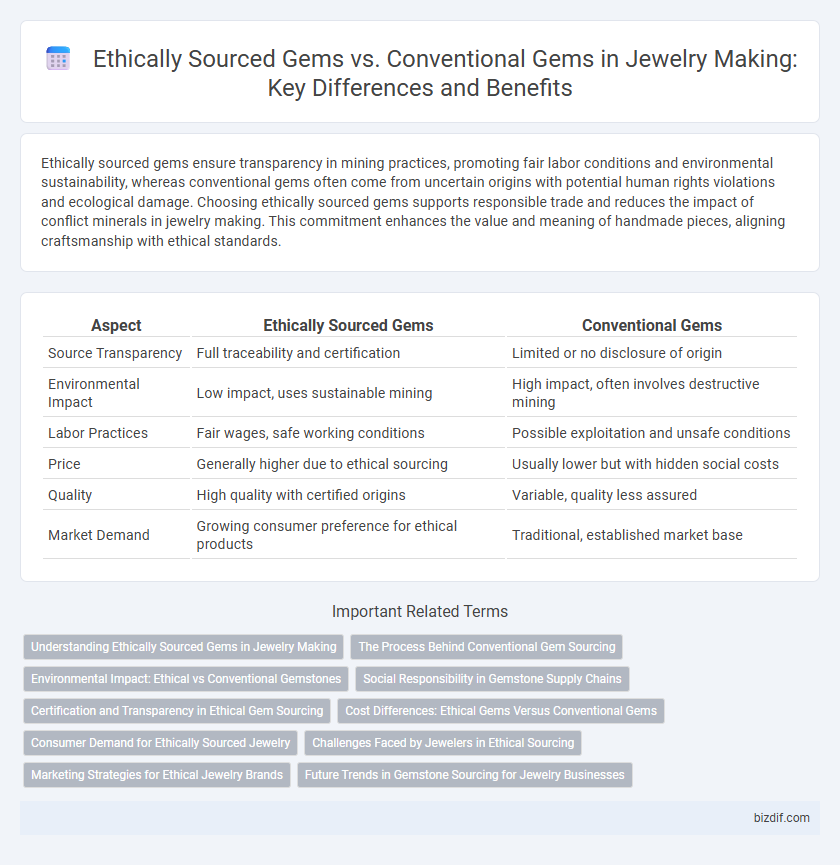Ethically sourced gems ensure transparency in mining practices, promoting fair labor conditions and environmental sustainability, whereas conventional gems often come from uncertain origins with potential human rights violations and ecological damage. Choosing ethically sourced gems supports responsible trade and reduces the impact of conflict minerals in jewelry making. This commitment enhances the value and meaning of handmade pieces, aligning craftsmanship with ethical standards.
Table of Comparison
| Aspect | Ethically Sourced Gems | Conventional Gems |
|---|---|---|
| Source Transparency | Full traceability and certification | Limited or no disclosure of origin |
| Environmental Impact | Low impact, uses sustainable mining | High impact, often involves destructive mining |
| Labor Practices | Fair wages, safe working conditions | Possible exploitation and unsafe conditions |
| Price | Generally higher due to ethical sourcing | Usually lower but with hidden social costs |
| Quality | High quality with certified origins | Variable, quality less assured |
| Market Demand | Growing consumer preference for ethical products | Traditional, established market base |
Understanding Ethically Sourced Gems in Jewelry Making
Ethically sourced gems in jewelry making are mined and procured with strict adherence to environmental sustainability and fair labor practices, ensuring minimal harm to ecosystems and communities. These gems often come with certifications such as Fairmined or the Responsible Jewellery Council, verifying their traceability and ethical origins. Choosing ethically sourced gems enhances transparency in the supply chain and supports the movement towards responsible luxury in the jewelry industry.
The Process Behind Conventional Gem Sourcing
Conventional gem sourcing typically involves extensive mining operations that prioritize high yield over environmental and social impacts, often resulting in habitat destruction and labor exploitation. Mining processes such as open-pit, alluvial, or underground extraction disrupt ecosystems and generate significant waste, while supply chains may lack transparency, increasing risks of conflict gems entering the market. This approach contrasts sharply with ethical sourcing practices that emphasize sustainability, fair labor standards, and traceability from mine to market.
Environmental Impact: Ethical vs Conventional Gemstones
Ethically sourced gemstones are mined using sustainable methods that minimize habitat destruction, reduce water pollution, and lower carbon emissions compared to conventional gemstone mining. Conventional gem mining often involves extensive land degradation, toxic chemical usage, and significant ecological disruption. Choosing ethical gemstones supports environmentally responsible practices that protect ecosystems and promote biodiversity.
Social Responsibility in Gemstone Supply Chains
Ethically sourced gems prioritize fair labor practices, community empowerment, and environmental sustainability throughout the gemstone supply chain, reducing exploitation and promoting transparent sourcing. Conventional gems often involve mining operations linked to questionable labor conditions, child labor, and environmental degradation, contributing to social and ecological harm. Supporting ethical sourcing reshapes the jewelry industry by ensuring gemstones are procured with respect to human rights and ecological balance.
Certification and Transparency in Ethical Gem Sourcing
Certification bodies such as the Responsible Jewellery Council and Fair Trade organizations provide rigorous auditing processes that ensure ethical sourcing of gems, focusing on environmental sustainability and fair labor practices. Transparent supply chains in ethically sourced gems offer traceability from mine to market, reducing risks of conflict gems and supporting consumer confidence. Conventional gems often lack such detailed certification and transparency, increasing potential exposure to unethical practices and market opacity.
Cost Differences: Ethical Gems Versus Conventional Gems
Ethically sourced gems typically incur higher costs due to sustainable mining practices, fair labor wages, and environmental protections, which increase production expenses compared to conventional gems. Conventional gems often come at a lower price point because of mass mining techniques that prioritize efficiency and volume over ethical considerations. The price difference reflects the true cost of ethical sourcing, promoting transparency and responsible consumer choices in the jewelry market.
Consumer Demand for Ethically Sourced Jewelry
Consumers increasingly prioritize ethically sourced gems over conventional gems due to rising awareness of environmental impact and human rights concerns in mining practices. Demand for ethically sourced jewelry drives jewelers to adopt transparent supply chains and certification programs such as Fair Trade and the Responsible Jewellery Council. This shift reflects a growing market trend where buyers value sustainability, traceability, and social responsibility in their gemstone purchases.
Challenges Faced by Jewelers in Ethical Sourcing
Jewelers face challenges in ethical sourcing due to limited availability and higher costs of ethically sourced gems compared to conventional ones, impacting pricing and inventory management. Supply chain transparency demands rigorous verification processes to ensure gems are conflict-free and sustainably mined, increasing time and resource investment. Balancing consumer demand for affordability with commitment to ethical standards requires innovative sourcing strategies and strong supplier relationships.
Marketing Strategies for Ethical Jewelry Brands
Ethical jewelry brands emphasize transparently sourced gems, highlighting their environmental and social impact to attract conscientious consumers. Marketing strategies leverage storytelling around fair labor practices and conflict-free certification to build trust and differentiate from conventional gem suppliers. Digital channels and influencer partnerships amplify these values, driving engagement and boosting sales among eco-conscious audiences.
Future Trends in Gemstone Sourcing for Jewelry Businesses
Future trends in gemstone sourcing for jewelry businesses emphasize a growing demand for ethically sourced gems, driven by consumer awareness of environmental and social impacts. Innovations in traceability technology, such as blockchain, enable transparent supply chains, ensuring the origin and ethical treatment of mined gems. Conventional gems face increasing scrutiny, prompting a shift towards sustainable practices and lab-grown alternatives to meet market expectations.
Ethically sourced gems vs Conventional gems Infographic

 bizdif.com
bizdif.com